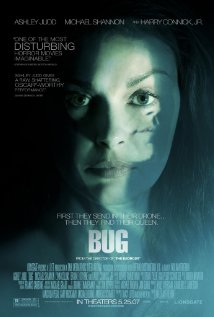It’s difficult to discuss William Friedkin’s “Bug” because, like his 1973 classic “The Exorcist” before it, it relies on atmosphere, not events. One can only go so far in stating the synopsis because it is a film that demands you know the bare essentials going in.
Primarily, “Bug” concerns a woman who has seized to believe in much of anything, and what lengths she will go to believe again. It is also about the influence that one person can have on another, especially when it comes to radical beliefs. And it begs the question: can one person’s reality, no matter how fantastical, become someone else’s, even when this reality could be false? Agnes White (Ashley Judd, in one of her very best performances) has been living in the Rustic Motel, a rundown joint in the South West. She has been receiving mysterious phone calls from someone (she believes it is be her ex-husband Jerry, who has just been released from prison.) One night she gets a visit from her friend and sometimes-girlfriend R.C. (Lynn Collins), who has brought with her a strange man named Peter Evans (Michael Shannon). “What do you think?”, asks R.C. “He may be an ex-murderer,” Agnes whispers. The three drink and when R.C. goes home, Peter offers to stay. Agnes is timid at first; Peter is strangely odd and tends to talk in a monotonous voice, but he doesn’t seem dangerous. He tells her he “picks up on things” and that he can tell she is lonely. She doesn’t disagree, and tells him it’s nice to have someone around. He speaks of his time in the Marines, about hidden machinery watching American citizens, about secret experiments, and Agnes just listens. Peter spends the night but in the morning, there is a surprise awaiting Agnes.
That is where I must stop. I went in knowing absolutely nothing about the film and it was this factor that had me enjoying “Bug” so much. Besides a few clichés towards the beginning (such as the repeated phone calls) the story is gripping because of the smart but unadorned dialogue and the acting from Judd. There is a scene later in the film when Judd and Shannon are discussing different kinds of bed bugs, and the two are so quick and funny with their dialogue that it seems improvised.
But isn’t this a horror film? In a way, yes. There are horror elements, but not in the sense as recent horror movie endeavors. There is hardly an horror violence; it is, for the most part, a sense of dread, and the awareness that what is happening to these two characters may not be real.
It is based on a play by Trecy Letts, who adapted his play for the screen. The structure of the film stays true to the stage version, as it, for the most, takes place entirely in a motel room. Only occasionally are we let outside, and when we are, it is from a view above in a helicopter. The helicopters, in fact, are used as a device to signal a growing threat. Very often in scenes in the motel room we hear the sound of helicopters passing by, a reminder that the characters are being watched. But are they really there, or are we hearing them through the ears of the characters? Friedkin uses harsh, warm lighting in the motel room and a mixture of shaky camera-work with static shots, sometimes letting the actors do their character work, sometimes taking the initiative to create tension. There is no visible antagonist, like there was in “The Exorcist”. We are never sure if these bugs that are eventually terrorizing the two main characters are real or merely schizophrenic delusions. Whatever the answer, however, it is soon happening to the two of them and any sense of objectivity in the film is gone.

